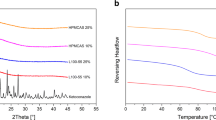Abstract
Purpose. To investigate changes in drug dissolution on storage of ternary solid-dispersion granules containing poorly water-soluble drugs.
Methods. Hot-melt granulation was used to prepare ternary solid-dispersion granules in which the drug was dispersed in a carrier and coated onto an adsorbent. Seven drugs including four carboxylic acid-containing drugs (BAY 12-9566, naproxen, ketoprofen, and indomethacin), a hydroxyl-containing drug (testosterone), an amide-containing drug (phenacetin), and a drug with no proton-donating group (progesterone) were studied. Gelucire 50/13 and polyethylene glycol (PEG) 8000 were used as dispersion carriers whereas Neusilin US2 (magnesium aluminosilicate) was used as the surface adsorbent.
Results. Two competing mechanisms have been proposed to explain the complex changes observed in drug dissolution upon storage of solid dispersion granules. Conversion of the crystalline drug to the amorphous hydrogen bonded (to Neusilin) state seems to increase dissolution, whereas, the phenomenon of Ostwald ripening can be used to explain the decrease in drug dissolution upon storage. The solubility of the drug in Gelucire is a crucial factor in determining the predominant mechanism by governing the flux toward the surface of Neusilin. The mobility for this phenomenon was provided by the existence of the eutectic mixture in the molten liquid state during storage.
Conclusions. A competitive balance between hydrogen bonding of the drugs with Neusilin and Ostwald ripening determines drug dissolution from solid-dispersion granules upon storage.
Similar content being viewed by others
REFERENCES
J. L. Ford. The current status of solid dispersions. Pharm.Acta Helv. 61:69-88 (1986).
W. L. Chiou and S. Riegalman. Pharmaceutical applications of solid dispersion systems. J.Pharm.Sci. 60:1281-1302 (1971).
A. T. M. Serajuddin. Solid dispersions of poorly water-soluble drugs: Early promises, Subsequent problems, and recent breakthroughs. J.Pharm.Sci. 88:1058-1066 (1999).
C. Leuner and J. Dressman. Improving drug solubility for oral delivery using solid dispersions. Eur.J.Pharm.Bio. 50:47-60 (2000).
M. K. Gupta, D. Goldman, R. H. Bogner, and Y. Tseng. Enhanced drug dissolution and bulk properties of solid dispersions granulated with a surface adsorbent. Pharm.Dev.Technol. 6:563-572 (2001).
M. K. Gupta, R. H. Bogner, D. Goldman, and Y. Tseng. Mechanism for further enhancement in drug dissolution from soliddispersion granules. Pharm.Dev.Technol. 7:103-112 (2002).
I. Chang and G. E. Maciel. Probing hydrogen bonding and the local environment of silanols on silica surfaces via nuclear spin cross polarization dynamics. J.Am.Chem.Soc. 118:401-406 (1996).
I. Chang and G. E. Maciel. A detailed model of local structure and silanol hydrogen bonding of silica gel surfaces. J.Phys.Chem.B. 101:3052-3064 (1997).
T. Watanabe, N. Wakiyama, F. Usui, M. Ikeda, T. Isobe, and M. Senna. Stability of amorphous indomethacin compounded with silica. Int.J.Pharm. 226:81-91 (2001).
T. Matsumoto and G. Zografi. Physical properties of solid molecular dispersions of indomethacin with poly(vinylpyrrolidone) and poly(vinylpyrrolidone-co-vinyl-acetate) in relation to indomethacin crystallization. Pharm.Res. 16:1722-1728 (1999).
F. Pozzi, A. Longo, C. Lazzarini, and A. Carenzi. Formulations of ubidecarenone with improved bioavailability. Eur.J.Pharm.Biopharm. 37:243-246 (1991).
P. C. Sheen, S. I. Kim, J. J. Petillo, and A. T. M. Serajuddin. Hydrogen Bonding with Adsorbent during Storage Governs Drug Dissolution 1671 Bioavailability of a poorly water-soluble drug from tablet and solid dispersion in humans. J.Pharm.Sci. 80:712-714 (1991).
D. Q. M. Craig. Polyethylene glycols and drug release. Drug Dev.Ind.Pharm. 16:2501-2526 (1990).
J. C. Price. Polyethylene glycol. In: A. Wade and P. J. Weller (eds.), Handbook of Pharmaceutical excipients, The Pharmaceutical Press, London, 1994 pp. 355-361.
Company literature on Neusilin. Fuji Chemical Industry Co. Ltd., Toyama Japan, pp. 3-4.
L. S. Taylor and G. Zografi. Spectroscopic characterization of interactions between PVP and indomethacin in amorphous molecular dispersions. Pharm.Res. 14:1691-1698 (1997).
N. Hirasawa, K. Danjo, M. Haruna, and A. Otsuka. Physicochemical characterization and drug release studies of naproxen solid dispersions using lactose as a carrier. Chem.Pharm.Bull. 46:1027-1030 (1998).
R. M. Silverstein, G. C. Bassler, and T. C. Morrill. Spectrometric identification of organic compounds, John Wiley and Sons, Inc., New York, 1991.
R. Suryanarayanan. X-ray powder diffractometry. Drugs Pharm.Sci 70:187-221 (1995).
R. Duclos, J. Grenet, J. M. Saiter, P. Besancon, and A. M. Orecchioni. Effect of ageing on progesterone-polyethylene glycol 6000 dispersions, X-ray study. Drug Dev.Ind.Phar 16:255-265 (1990).
K. Arnold, A. Herrman, L. Pratsch, and K. Gawrisch. The dielectric properties of aqueous solutions of poly (ethylene glycol) and their influence on membrane structure. Biochim.Biophys.Acta 815:515-518 (1985).
M. Muramatsu, M. Iwahashi, and U. Takeuchi. Thermodynamic relationship between ? and ?-forms of crystalline progesterone. J.Pharm.Sci. 68:175-177 (1979).
S. Shamblin, X. Tang, L. Chang, B. Hancock, and M. J. Pikal. Characterization of the time scales of molecular motion in pharmaceutically important glasses. J.Phys.Chem.B 103:4113-4121 (1999).
P. Tong and G. Zografi. Solid state characteristics of amorphous sodium indomethacin relative to its free acid. Pharm.Res. 16:1186-1192 (1999).
J. A. Searles, J. F. Carpenter, and T. W. Randolph. Annealing to optimize the primary drying rate, reduce freezing induced drying rate heterogeneity, and determine Tg' in pharmaceutical lyophilization. J.Pharm.Sci. 90:872-887 (2001).
W. Bender and L. Ratke. Ostwald ripening of liquid phase sintered Cu-Co dispersions at high volume fractions. Acta Matter 46:1125-1133 (1998).
A. J. Ardell. Microstructural stability at elevated temperatures. J.Eur.Ceramic Soc. 19:2217-2231 (1999).
H. Eliasen, T. Schaefer, and H. G. Kristensen. Effects of binder rheology on melt agglomeration in a high shear mixer. Int.J.Pharm. 176:73-83 (1998).
Company literature on Carbowax. Polyethylene glycols and methoxypolyethylene glycols, Union Carbide, Danbury, Connecticut, pp. 15-17. Gupta et al. 1672
Author information
Authors and Affiliations
Corresponding author
Rights and permissions
About this article
Cite this article
Gupta, M.K., Tseng, YC., Goldman, D. et al. Hydrogen Bonding with Adsorbent During Storage Governs Drug Dissolution from Solid-Dispersion Granules. Pharm Res 19, 1663–1672 (2002). https://doi.org/10.1023/A:1020905412654
Issue Date:
DOI: https://doi.org/10.1023/A:1020905412654




